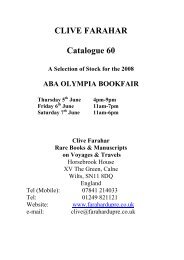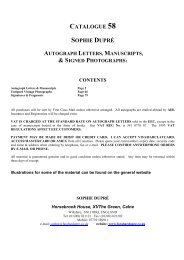You also want an ePaper? Increase the reach of your titles
YUMPU automatically turns print PDFs into web optimized ePapers that Google loves.
23 AUTOGRAPH LETTERS,MANUSCRIPTS &SIGNED PHOTOS<br />
173. BISHOP (Isabella Lucy, née Bird, 1831-1904,<br />
Traveller & Authoress)<br />
Autograph Postcard signed toMr.Woolmer,whoisstaying<br />
at Salen on Mull, saying “As Ito, my Japanese servant truly<br />
observed, ‘Nothing is worth anything that is not true’”, and<br />
hastening “to correct my statement concerning Anio boats<br />
... I find they are practically ‘dug-outs’ but made in two<br />
halves ... laced together by strong bark fibre twine a high<br />
‘gunwale’ being laced on finally”, and hoping that he and<br />
Mr Ross “will find your way over here again”, 1 side<br />
postcard with printed stamp, The Cottage, Tobermory,<br />
Mull, 22nd August 1888, faint trace of gum in right margin<br />
of verso [SD26492]£475<br />
Isabella suffered from poor health throughout her life, particularly<br />
from back problems. She found that travel to distant parts<br />
alleviated her symptoms which is quite extraordinary considering<br />
the discomfort of nineteenth century travel, but may suggest that<br />
some of her ailments were psychological. By 1878 she had<br />
already visited America, Australia, New Zealand and the<br />
Sandwich Islands and then she spent seven months in Japan. Her<br />
book of this journey ‘Unbeaten Tracks in Japan’ was published in<br />
1880 and was remarkable for her descriptions of the Ainu people<br />
of Hokkaido. She married Dr Bishop in 1881 but started<br />
travelling again in 1886 after his death. She studied medicine &<br />
went on to found hospitals in Kashmir, the Punjab and elsewhere<br />
in memory of her husband and her sister. In 1892 she was elected<br />
the first lady F.R.G.S.<br />
Isabella Bird was one of the most liberated and strong minded<br />
women of the mid nineteenth century and her books remain<br />
popular. She also published ‘The Englishwoman in America’,<br />
18<strong>56</strong>, ‘The Hawaiian Archipelago’, 1875, ‘A Lady’s Life in the<br />
RockyMountains’, 1879<br />
174. BLACKIE (Prof. John Stuart, 1809-1895, Scottish<br />
manofletters)<br />
ALS asking his publisher to send “a copy of my Selfculture<br />
to the enclosed address and affix the papers to the<br />
fly-leaf”, 2 sides 8vo., London (with in pencil ‘22 Arle St.<br />
Edin.’), 28th January n.y., c. 1875, light traces of old tabs<br />
on verso [SD16789]£25<br />
Blackie was professor of Greek at Edinburgh, 1852-1882, and<br />
founded a Celtic chair there on his retirement.<br />
175. BOEHM (Sir J. Edgar, R.A., 1834-1890, 1st Bart.,<br />
Austrian-born Sculptor)<br />
ALS to‘Dear Glaseby’, asking him to send “the Bronze<br />
group ofthe Arab horse with Selim the negro ... to Mrs<br />
Hammond ... Have it a little brushed before leaving”, 1 side<br />
8vo., Highcliff, Christchurch, Hampshire, n.d., c. 1880,<br />
faint traces of laying down on conjugate blank<br />
[SD24359]£35<br />
Boehm exhibited at the Royal Academy from 1862 and soon had<br />
an extensive portrait practice. He was sculptor in ordinary to<br />
Queen Victoria and designed her portrait for the silver coinage of<br />
1887.<br />
176. BOUGHTON (George Henry, 1833-1905, Painter &<br />
Illustrator)<br />
ALS to Frederick HOLLYER (1837-1933,<br />
Photographer), asking him to “let me have the Burne<br />
Jones’ photos - with the numbers and list ...”, 1 side 8vo.,<br />
West House, Campden Hill headed paper, 26th March 1886<br />
[SD5190]£60<br />
177. BONAMICI (Antonio, Student at the Seminary at<br />
Frascati)<br />
Printed Heads of his Disputation ‘On the Mystery of the<br />
Trinity’, in Latin, to be argued on 3rd September before<br />
Giovanni Battista Arinio, on the title is the dedication to<br />
Henry, Cardinal York, (1725-1809, the last Stuart<br />
pretender), “Bishop of Frascati, most ample patron”, with a<br />
fine woodblock of the Stuart Arms of Great Britain,<br />
differenced with a crescent, the Cardinal’s hat above,<br />
stitched, 8 sides 8vo., Frascati (ancient Tusculum), at the<br />
Seminary’s Printing Press, 1787, crisp copy, with a little<br />
very light foxing [SD50195]£125<br />
Henry was Bishop of Frascati for over forty years, 1761-1803.<br />
178. BOOSEY (Thomas, c.1795-1871, Music Publisher)<br />
ALS to the music publisher S. Cocks, 6 New Burlington<br />
Street, saying he shall be happy “to give Mr Bentley any<br />
information ... relating to the present position of my two<br />
Actions on the Sonnambula Copyright ,or... I have no<br />
doubt my Solicitor Mr Comyn ... who ... has the pleasure of<br />
knowing Mr Bentley will be happy to satisfy him”, 2 sides<br />
8vo. and original autograph envelope, 28 Holles Street,<br />
24th May 1850, envelope neatly attached by flap to blank<br />
third side [SD16803]£40<br />
Thomas Boosey began as a foreign book seller in Holles Street,<br />
Oxford Street. He published the Italian operas of Bellini,<br />
Donizetti & Verdi down to 1854, when a decision of the House of<br />
Lords deprived him of all his copyrights.<br />
179. BOULANGER (Georges, 1837-1891, French<br />
General and Minister of War)<br />
ALS to an unnamed correspondent, in French with<br />
translation, saying he will “put things right for the young<br />
man from the Conservatoire”, and will recommend “the<br />
young man who has been a volunteer for a year, and who<br />
passed his exam on Monday ... you will always find me at<br />
home between 10 and 11”, 1 side 8vo., Grand Hôtel Du<br />
Louvre, Paris, ‘Saturday’ n.d., c. 1886 [SD24363]£45<br />
Boulanger rose on a wave of populism, based on his reforms in<br />
the army for officers and men alike, and on his policy of revenge<br />
for the war of 1870. Taken up by the radicals, he was Minister of<br />
War from January 1886 to May 1887. However, a new<br />
government found him inconveniently prominent, and was glad<br />
when he resigned. The Paris mob clamoured for their “brav’<br />
général”, who became a familiar figure on his black horse. During<br />
1888 his personality dominated French politics, and the royalists<br />
saw in him a chance to defeat the parliamentary Republic. In<br />
April 1889 he fled Paris, for which he had been elected to the<br />
Assembly, faced with a warrant for his arrest for treason. In 1891<br />
he shot himself in Brussels by his mistress’ grave.<br />
180. BOWLES (Revd. William Lisle, 1762-1850, Divine,<br />
Poet and Antiquary)<br />
ALS to‘Dear Merewether’, asking him to “come and dine<br />
here to day at five o’clock to meet Duncan”, 1 side small<br />
8vo., n.p., ‘Friday Morn.’, n.d., c. 1820, faint traces of<br />
laying down at corners of blank verso [SD16811]£45<br />
A forerunner of the Romantic movement, Bowles’ ‘Fourteen<br />
Sonnets, written chiefly on Picturesque Spots during a Journey’,<br />
1789, had Coleridge, Wordsworth and Southey among its<br />
enthusiastic admirers. His edition of Pope, 1806, led to a long<br />
controversy, 1809-1825, in which Campbell and Byron were his<br />
chief antagonists.





